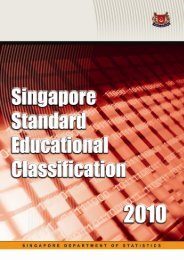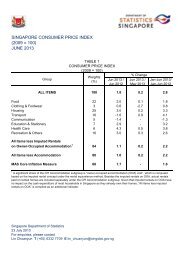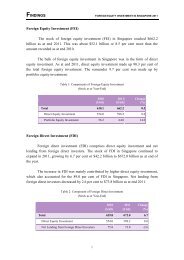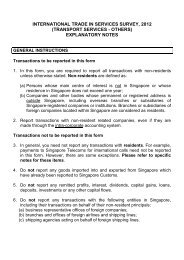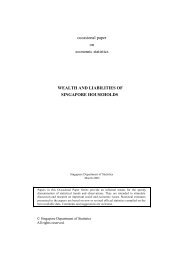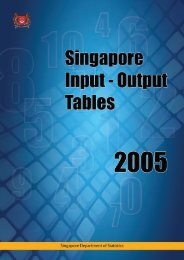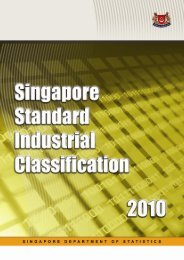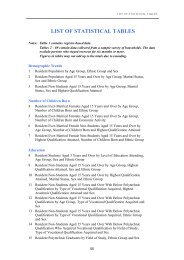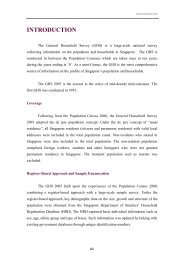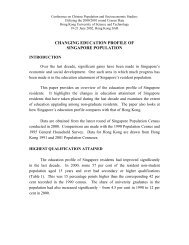Paper - Statistics Singapore
Paper - Statistics Singapore
Paper - Statistics Singapore
- No tags were found...
You also want an ePaper? Increase the reach of your titles
YUMPU automatically turns print PDFs into web optimized ePapers that Google loves.
11. Central death rates at single year of age x are then derived using linearinterpolation. For the purpose of linear interpolation, m n xis treated as the singleyear central death rate at the mid-point of its corresponding age group. That is, m7is set as m 5 5, m as m 12 5 10, and so on7 . Mortality rate at age 1 ( m 1) is taken to bem 4 1without any interpolation to avoid unnecessary distortion due to thedomination of m0. The remaining values of the single year central death rates arethen derived using linear interpolation method.12. To ensure that there is a smooth progression of mortality rates with age, thederived for each single year of age x was graduated using the Whittaker-m xHenderson method of graduation. Graduated death ratesminimise the following equation:gm xare chosen toJ = F + hS ≡n∑x=0( mgx− m )x2+ hn-3∑x=03( ∆ mgx)2wherem xgm xis the initial estimate of death rate at age xis the graduated value of the death rate at age xh is a non-negative parameter∆ is a forward difference operator13. In the equation, F is a measure of fitness and S is a measure of smoothness.The relative importance of smoothness and fit is determined by the value of h. Alarge value will optimise smoothness while a small value will optimise fit. Tobalance goodness of fit and smoothness, h is chosen to be 0.5 8 . Small changes in hhave a negligible effect on the overall result.14. The death rate at age 0, m 0, is significantly larger than the death rates atages 1 to 4. To ensure that the graduated death rates reflect the underlying deathm1rates at ages 1 to 4, a pseudo m 0(computed as m1× ) replaces the original m 0m2during the graduation process9 .7refers to the death rate among persons aged x to x+n-1, where x is the lower limit of the age groupn m xand n refers to the duration in years after age x. In instances where n=1, the left subscript n is omittedaccording to usual conventions.8 This is used in the paper “Estimation of Complete Period Life Tables for <strong>Singapore</strong>ans” published in theJournal of Actuarial Practice Vol 11, 2004.9 This approach is adopted by the Hong Kong <strong>Statistics</strong> and Census Department.3



